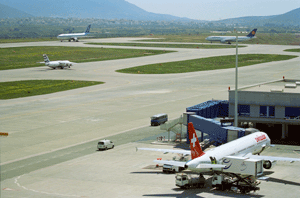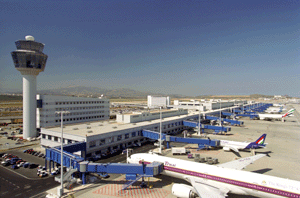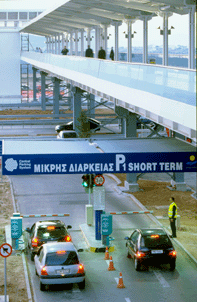|
By Andrew Leech, |
|||||
After passing Flebes Island on a compass direction of 03 degrees, the plane lowers altitude and drops undercarriage. Speed slackens and pilots can see the old airport of Ellinikon on the left and the two runways of Venizelos ahead. To the left in Hymittos and on the right is the range near Keratea and another near Saronida. This gives the impression of flying through a giant barn door However, no pilot at Venizelos considers this dangerous unless close to the ground -- just uncomfortable. Windshear can be deadly, of course, at the wrong moment and in sufficient strength. If they occur near ground level, windshears (sudden changes in wind direction) can drive an aircraft into the ground. That is what happened to Delta flight 191 in 1985. As the Boeing 737 approached Dallas-Fort Worth airport, a sudden downburst caused it to crash, killing 133 people. "By definition, a windshear is a weather event involving abrupt changes in wind speed and/or direction over a short distance. Windshears occurring at ground level are more accurately referred to as downbursts. If the windshear encounter began at a low altitude, such as it would during a take off or landing, the overall loss of altitude may cause the aircraft to fly directly into the ground with catastrophic results." (Windshear E. Linacre and B. Geerts 9/98)
The main winds are those coming from the north. However, the various mountain ranges distort them, so a wind initially coming from the north may do a U-turn and suddenly become a southerly wind. After passing Flebes you encounter a tailwind that lifts the aircraft tail, causing you to lose altitude unless you compensate and increase engine power. It also (being behind you) increases forward speed at a time you want to reduce it for the landing approach. At 4DME, four nautical miles before reaching the runway, you meet the prevailing northern headwinds in their normal position. However, there is a transition period during which the plane is pushed by a southerly and faces a northerly wind simultaneously. This creates turbulence and can produce windshears. The average wind strength in this area is around 20 knots (nearly 40km) so even a large plane feels it, causing a phenomenon that both lifts and depresses the plane at the same time (causes an up down motion like a lunapark thrill ride) and alters the characteristics of the landing approach path. Fortunately, we usually pass that point before actually landing. It is to Spata's credit that they installed a specialized wind machine to detect turbulence and warn pilots, but this can do nothing to minimize it or improve passenger comfort, and pilots only receive up to date information just before encountering turbulence. Another point that came from a senior source at the Civil Aviation Authority, speaking under customary anonymity, was that Venizelos
Levels 1, 2, and 3 roughly refer to the generations of equipment and how precise they are. Level 1 on ILA brings you down to 200 ft. above the ground. If you can't see the runway, then you abort the landing and divert to another airport. It also covers 700-ft. visibility ahead of you (RVR: runway visibility range). For a successful landing you need to see both ahead and below. Level 2 brings you down to 100 ft. above the ground with RVE of 1200 ft., while Level 3 brings you down to 50 ft. (in some cases to 7 ft.) and gives RVR of 1800 ft. So far the official recommendation is that Venizelos doesn't need a level higher than 1. The last disquieting point comes from the fact that if a plane cannot land at Venizelos it must divert to Thessaloniki or Crete: the nearest runways to handle jets of this size. You could theoretically include Mykonos, but if weather conditions were bad in Athens, they are likely to be worse in Mykonos, and transport to the mainland difficult. The military airports of Tanagra and Eleusis could provide viable alternatives in an emergency, such as fire, engine failure or fuel leak, when passengers' lives are in danger. But they are unlikely to give landing permission to commercial flights under merely windy circumstances. Aside from the security problems of civilians landing at an airbase, there would be the expense of busing them with luggage to Spata's immigration and customs authorities. Furthermore, Tanagra's military ILS system is incompatible with civilian versions. Since moving to Spata a furor has raged behind closed doors as to what to do with Ellinikon. While the government publicly maintains it would like to build a park, the mayors of the four local municipalities (Glyfada, Alimos, Ilioupolis and Kalamaki) have priva
However, local flying organizations, such as Aeroservices, Aero Leschi Ellinikon, Airman and other private services and clubs have offered a very viable alternative. Athens News talked to Dimitrios Daphnis and Petros Sakellariou. Carefully worked out drafts and area plans set aside 20% of available space for Ellinikon's continued use as an airport (small planes and helicopters that make little or negligible noise) leaving a full 80% for future development: either government or private. This plan would also cover maintenance costs of the ONLY nearby runway that could handle an emergency landing of a large jet and relieve the government of some expense. The question that remains is whether government and local mayors are willing to put a little water in their wine and sacrifice some profit in the interests of safety. With the nearest runways able to handle a diverted flight 600 kms away, Athens, may be unique in Europe in being the only capital city with a single major airport and an alternative more than 100 km distant. A certain recipe for disaster if bad weather coupled with severe technical malfunction or fuel shortage/leakage were to occur; if a flight could neither land a Venizelos nor make it to an alternative destination. We faced the same problem with Ellinikon in the past -- no nearby alternative runway -- but now there is a viable and cheap solution. An unfortunate Greek character trait focuses only on the present. Let us hope that safety and common sense prevails here and that, instead of merely looking at short-term financial profit, we can look ahead, in time, and ask ourselves the only questions that counts: "supposing my child or family were on an endangered flight?" Do we wait for an incident before we lose our complacency and act? |
|||||
|
"Ellinikon Airport: Salvation or White Elephant?" first appeared in the September 2001 issue of Greek-American Review, a national monthly magazine published by Hellenic Heritage, Ltd., 7th Avenue, New York, NY 10001. For more information, visit www.estiatoronline.com. |






